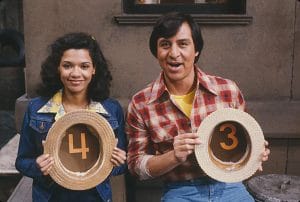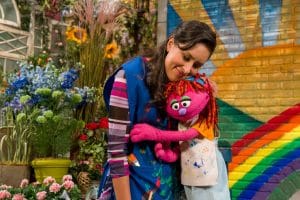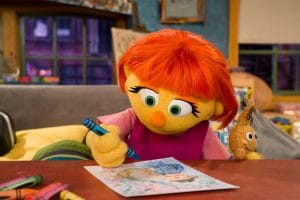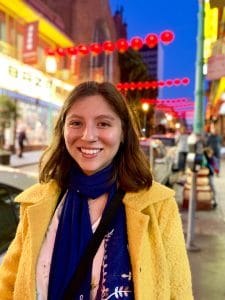Fifty years since its inception, Sesame Street still sets the standard for representation and diversity on television.
By Victoria Gonzalez
The following article originally appeared on PBSSoCal.org.

Rosita, the first Hispanic Muppet. | Courtesy of Sesame Workshop and Richard Termine
It’s around 1999 in Tijuana, and I’m lying down with my tummy to the rug and my face in my hands as I try to remember what I just heard from my brother’s stuffed singing little red monster. It goes A-B-C-D-E-F-G-H … is the next one J?
I’m just four years old, and this little red monster already occupies a very important part in my heart. Kind and gentle, Elmo is my favorite Muppet on Sesame Street, which I watch with an almost religious fervor as I eat my morning cereal. I give up trying to remember how the song goes and press Elmo’s tummy again. Even though the sound quality is a bit scratchy, the familiar tune swaddles my young brain like a blanket as soft as Elmo himself, and I sing along to the alphabet song.
Twenty years later, that song still swirls around in my head. That stuffed Elmo’s mechanical heart has become worn, and the sound quality is poor at best, but that little red monster is still significant. Had it not been for Elmo and Sesame Street, learning my ABCs in English would have felt akin to downing castor oil rather than honey.
Fifty years since its inception, besides teaching us our ABCs, Sesame Street still demonstrates how to deal with our differences and sets the standard for representation and diversity on television.
Diversity from the Start
Sesame Street aired November 10, 1969. Before the first minute of the first episode is over, we see a cast of children of different skin colors playing together because that’s just what’s expected and normal. The choice of an integrated cast would be a natural one today, but in 1969, only four years after the march for civil rights from Selma to Montgomery, such a choice was revolutionary. It was only until the ‘70s that Americans started to see people of color regularly depicted on television.
For Sesame Street creators, this was a conscious choice from the very beginning. In his book Street Gang: The Complete History of Sesame Street, Michael Davis describes how in early show development seminars, it was decided that the cast would be integrated to stick to the show’s original goal: to serve all children, no matter their economic class, with indigent children being the main objective. At the time, this group undoubtedly included children of color. However, as Davis writes, “nothing would be done artificially to draw attention to their diversity and harmony. The actors would regard each other with kindness, respect and tolerance.” We can clearly see that diversity in Gordon and Susan Robinson, played by Matt Robinson and Loretta Long, a kind, childless couple who caters to the children of Sesame Street. The Robinsons were the start, but more characters and cast members would soon follow. Gordon was a particularly important character because he represented a respected father figure at a time when stereotypes about black men pointed in the opposite direction.
Criticism as a Force for Change

Maria and Luis, played by Sonia Manzano and Emilio Delgado. | Courtesy of Sesame Workshop
For all the first season’s diversity, Sesame Street didn’t always get it right the first time out of the gate, but true to its spirit of education, the show grew and changed as the public demanded it.
In the beginning, and despite the integrated cast, the show notably lacked Hispanic and Latino characters, for which it was criticized. Sesame Street responded with the arrival of Maria, played by Sonia Manzano, and Luis the repairman, played by Emilio Delgado, in 1971.
Co-creator Joan Ganz Cooney also faced criticism for the role of Susan. Feminist groups disliked that Susan was originally relegated to the role of housewife, an occupation that was slowly becoming less common at the time, so eventually, Susan got a job as a nurse and Carole Hart, Sesame Street’s first credited female writer, was hired.
Everyone Fits In at Sesame Street
Over time, the underlying philosophy portrayed in Sesame Street, that we are all the same no matter the color of our skin, became even more cemented. The program’s consciousness-expanding characters continued with the addition of Buffy Sainte-Marie in 1975, a Native American singer who bewitched audiences with her enchanting performances. Legend goes that when Sesame Street producer Dulcy Singer first approached Sainte-Marie to appear in the show, she was hesitant. After a little bit of thought though, Sainte-Marie took the idea further and proposed teaching children about Native American culture, proudly showing off her ancestry in an effortless way.
In her uncomplicated manner, Sainte-Marie even showed young audiences what breastfeeding looked like in a way that normalized the practice and was easy to understand. At the time, breastfeeding was starting to experience a moment of public acceptance in media, but enthusiasm for showing the practice on television has since waned, as women still face feeling shameful and are criticized for feeding their babies in this way. When Big Bird remarks that that’s “a funny way to feed a baby,” Buffy gently replies that it’s “nice and warm and sweet and natural, and it’s good for him. And I get to hug him while I do it, see?”

Lily with Sofia, played by Jasmine Romero. | Courtesy of Sesame Workshop and Richard Termine
Sesame Street goes beyond just teaching the alphabet and numbers. In 2011, the series introduced us to Lily, a Muppet who faced food insecurity. Reflecting the homelessness crisis facing the United States, in 2018, her story changed, making her the first Muppet to represent what it’s like to live with homelessness, as part of an ongoing initiative to address the issue. Sherrie Westin, president of global impact and philanthropy for Sesame Workshop, told CNN the reasoning behind the choice. “With any of our initiatives, our hope is that we’re not only reaching the children who can identify with that Muppet but that we’re also helping others to have greater empathy and understanding of the issue.”
The series also exposed a whole generation of children to sign language. But that was just the beginning of the series’ foray into other languages. In 1979, Linda Bove, who communicated using American Sign Language (ASL), was added to the cast, playing Linda the librarian. In the beginning, Bove thought her character was too one-dimensional, as writers on the show were more focused on the ways deaf people do things differently and how courageous it was to be deaf. Bove turned that on its head. “It was not a big deal,” she said in a 1991 interview. “I have a sense of humor; why don’t you show that? I can be angry over something. Show that I can have a relationship with another person.” This would set the mold for portraying individuals with disabilities in the future.
Other Abilities

Julia, the first Muppet with autism, draws with a crayon. | Courtesy of Sesame Workshop and Richard Termine
Like with characters of different racial backgrounds, representation of disabled people on television at the time of the creation of Sesame Street was limited at best to nonexistent at worst. Before there was Julia, the esteemed Muppet who showed children what autism looked like in 2017, a toddler by the name of Jason Kingsley proved having Down syndrome was not a death sentence, much less a deterrent to having fun. The son of Sesame Street writer Emily Kingsley, Jason was practically deemed a lost cause, and his mother was told to just send him away to an institution. Kingsley knew in her gut that was wrong. “[We] decided that you don’t write off a person because of the label that he carries,” she told Today in 2018. As we can see in a clip of Jason showing viewers the letter “s” and pointing to his shoes with Cookie Monster on Sesame Street in 1979, she was right.
Once that barrier had been broken, even Tarah Schaeffer’s osteogenesis imperfecta (a condition that affects bones, making them prone to breaking) wasn’t a handicap to enjoying life. Cheerful and charming, Schaeffer, who joined the cast in 1993, performed ballet and raced in her wheelchair. A 1994 Sesame Workshop newsletter summed it up: “Wheelchair-bound Tarah proves over and over again that all kids like to play, laugh, learn, and have fun! Her spunky presence has helped children learn about the needs (and strengths!) of children with disabilities.”
Before Tarah raced around in her wheelchair, a Muppet named Aristotle championed another different ability: blindness. Called Ari, this fuzzy blue Muppet who loves collecting things taught Big Bird about Braille and that being blind didn’t stop him from making sandwiches. If there’s one thing my four-year-old mind took away from Sesame Street it’s that, as Alan (played by Alan Murakoa) says about Julia: it’s perfectly ok when someone “does things just a little differently.”
As a child, I don’t remember noticing that the cast was so diverse and accepting of each other, but I definitely notice it as an adult, which makes me wonder, isn’t it a good thing that I never noticed that diversity, because it became normal to me from the start? If Sesame Street is any indication, seeing people who represent all of us should be an established, assumed fact and not a novel feature in media.
Sesame Street Crosses All Sorts of Borders

Kami, the first HIV-positive Muppet, poses in front of a sign from Sesame Street’s South African co-production, Talakani Sesame. | Courtesy of Sesame Workshop
You may be familiar with Rosita, the soft blue Muppet who is fluent in both English and Spanish, but have you ever heard of Rechov Sumsum’s Mahboub, the Arab-Israeli Muppet who tackles Middle Eastern cultural relations, or Takalani Sesame’s Kami, the HIV-positive South African Muppet who promotes HIV awareness?
Sesame Street has grown to have a global presence, with a long list of co-productions around the world based on the original series but adapted to specific countries. Unsurprisingly, it turns out that adorable puppets teaching us to be kinder is an idea that resonates with children of all cultures.
There are some 40 Sesame Street co-productions around the world, including innovative characters like México’s Abelardo, a large green parrot who stars in Plaza Sésamo and is Big Bird’s cousin; Zari from Afghanistan’s Baghch-e-Simsim, the first Afghan Muppet; Momon, a five-year-old Indonesian monster from Jalan Sesama; China’s Hu Hu Zhu, a fuzzy blue pig from Zhima Jie, among many others.
In 2011, Plaza Sésamo even partnered with Mexico’s National Institute of Indigenous Languages to dub an episode of the show into Náhuatl, one of Mexico’s indigenous languages, as a way to provide educational content for the country’s indigenous children. Although the characters of these co-productions are designed to reflect the cultures of the countries they are in, there have been some noteworthy efforts made to tackle serious issues that have international impact. Such is the case of Mahboub, who addressed the fierce tensions in the Middle East between Israel and Palestine. When Mahboub’s Palestinian friend Omar, who only speaks Arabic, comes to visit, Mahboub’s friends worry they won’t be able to communicate. Mahboub assures them that with him translating, it won’t be an issue. When Mahboub momentarily leaves to find a ball to play with, his friends stare awkwardly at each other until they realize that some words in Hebrew sound exactly the same in Arabic, proving that the two groups are more similar than they all thought. A few minutes later, the Israeli and Arab characters end up dancing together in harmony.
By showing children how Mahboub and his Israeli friends can easily communicate with Omar, the show positively influences the next generation to aim for peace, not war. It also shows that, as Mahboub and his friends realize, it’s possible to “understand without talking at all because you don’t need words to be a friend,” a lesson my four-year-old self would understand, and one I hope millions of future four-year-olds do too. It’s also a lesson we would all be well advised to keep in mind today. After being shown to children in almost 70 countries, from Afghanistan to Ukraine — brought to you by the letters A and U — we can be certain the show’s positive influence will live on, thanks to viewers like you.

Victoria Gonzalez
About the Author
Victoria Gonzalez is a journalist based in Southern California. She is interested in food cultures around the world, migration, David Bowie and ice cream. In addition to contributing to KCET, she has written (and fact-checked) for Los Angeles Magazine and San Diego Magazine. You can find her watching baking shows, eating tacos in her hometown of Tijuana or reading back issues of Lucky Peach.
Now celebrating its 50th anniversary year, Sesame Street airs weekdays at 11 a.m. and 1 p.m. on CPTV, and daily at 10 a.m. and 2 p.m. on CPTV PBS Kids 24/7.
